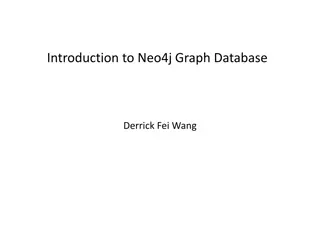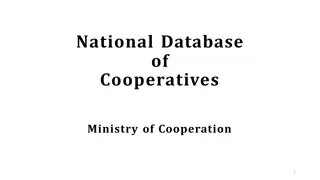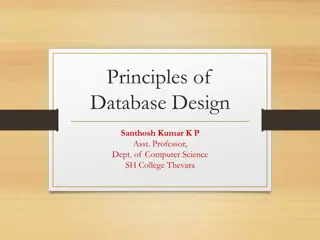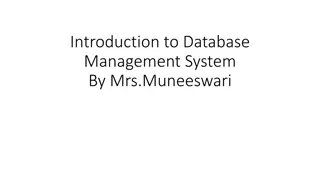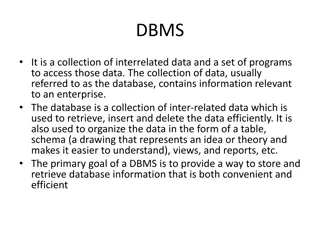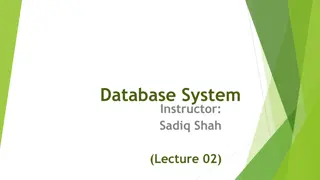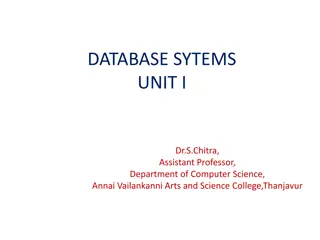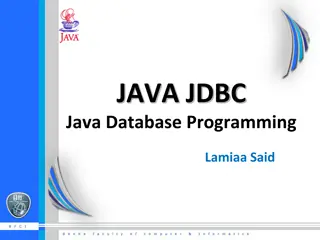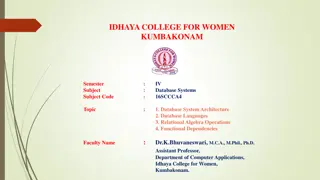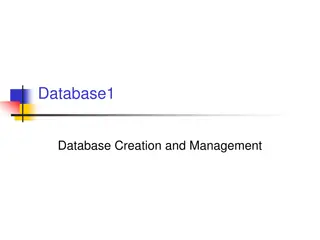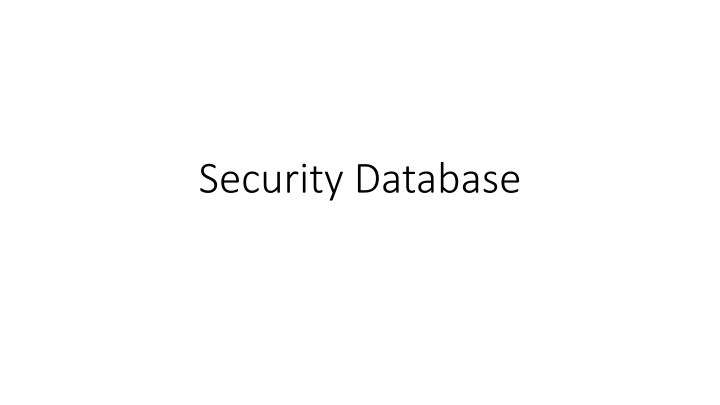
Security Database
Explore the features of Discretionary Access Control (DAC), Mandatory Access Control (MAC), and Role-Based Access Control (RBAC) in enhancing security measures. Learn about the flexibility and vulnerabilities of DAC, the rigid protection of MAC, and the role hierarchy in RBAC. Discover how RBAC addresses key security requirements for web-based applications compared to DAC and MAC models.
Download Presentation

Please find below an Image/Link to download the presentation.
The content on the website is provided AS IS for your information and personal use only. It may not be sold, licensed, or shared on other websites without obtaining consent from the author. If you encounter any issues during the download, it is possible that the publisher has removed the file from their server.
You are allowed to download the files provided on this website for personal or commercial use, subject to the condition that they are used lawfully. All files are the property of their respective owners.
The content on the website is provided AS IS for your information and personal use only. It may not be sold, licensed, or shared on other websites without obtaining consent from the author.
E N D
Presentation Transcript
Comparing Comparing Discretionary Access Control and Discretionary Access Control and Mandatory Access Control Mandatory Access Control Discretionary Access Control (DAC) policies are characterized by a high degree of flexibility, which makes them suitable for a large variety of application domains. The main drawback of DAC models is their vulnerability to malicious attacks, such as Trojan horses embedded in application programs.
Comparing Comparing Discretionary Access Control and Discretionary Access Control and Mandatory Access Control(2) Mandatory Access Control(2) By contrast, mandatory policies ensure a high degree of protection in a way, they prevent any illegal flow of information. Mandatory policies have the drawback of being too rigid and they are only applicable in limited environments. In many practical situations, discretionary policies are preferred because they offer a better trade-off between security and applicability.
Role Role- -Based Access Control Based Access Control Role-based access control (RBAC) emerged rapidly in the 1990s as a proven technology for managing and enforcing security in large-scale enterprise wide systems. Its basic notion is that permissions are associated with roles, and users are assigned to appropriate roles. Roles can be created using the CREATE ROLE and DESTROY ROLE commands. The GRANT and REVOKE commands discussed under DAC can then be used to assign and revoke privileges from roles.
Role Role- -Based Access Control (2) Based Access Control (2) RBAC appears to be a viable alternative to traditional discretionary and mandatory access controls; it ensures that only authorized users are given access to certain data or resources. Many DBMSs have allowed the concept of roles, where privileges can be assigned to roles. Role hierarchy in RBAC is a natural way of organizing roles to reflect the organization s lines of authority and responsibility.
Role Role- -Based Access Control (3) Based Access Control (3) Another important consideration in RBAC systems is the possible temporal constraints that may exist on roles, such as time and duration of role activations, and timed triggering of a role by an activation of another role. Using an RBAC model is highly desirable goal for addressing the key security requirements of Web-based applications. In contrast, discretionary access control (DAC) and mandatory access control (MAC) models lack capabilities needed to support the security requirements emerging enterprises and Web-based applications.
Access Access Control Policies for Control Policies for E E- -Commerce and the Web Commerce and the Web E-Commerce environments require elaborate policies that go beyond traditional DBMSs. In an e-commerce environment the resources to be protected are not only traditional data but also knowledge and experience. The access control mechanism should be flexible enough to support a wide spectrum of heterogeneous protection objects. A related requirement is the support for content- based access-control.
Access Access Control Policies for Control Policies for E E- -Commerce and the Web (2) Commerce and the Web (2) Another requirement is related to the heterogeneity of subjects, which requires access control policies based on user characteristics and qualifications. A possible solution, to better take into account user profiles in the formulation of access control policies, is to support the notion of credentials. A credential is a set of properties concerning a user that are relevant for security purposes For example, age, position within an organization It is believed that the XML language can play a key role in access control for e-commerce applications.
Introduction Introduction to Statistical Database Security Database Security Statistical databases are used mainly to produce statistics on various populations. The database may contain confidential data on individuals, which should be protected from user access. Users are permitted to retrieve statistical information on the populations, such as averages, sums, counts, maximums, minimums, and standard deviations. to Statistical
Introduction to Statistical Introduction to Statistical Database Security (2) Database Security (2) A population is a set of tuples of a relation (table) that satisfy some selection condition. Statistical queries involve applying statistical functions to a population of tuples.
Introduction Introduction to Statistical Database Security (3) Database Security (3) For example, we may want to retrieve the number of individuals in a population or the average income in the population. However, statistical users are not allowed to retrieve individual data, such as the income of a specific person. Statistical database security techniques must prohibit the retrieval of individual data. This can be achieved by prohibiting queries that retrieve attribute values and by allowing only queries that involve statistical aggregate functions such as COUNT, SUM, MIN, MAX, AVERAGE, and STANDARD DEVIATION. Such queries are sometimes called statistical queries. to Statistical
Introduction Introduction to Statistical Database Security (4) Database Security (4) to Statistical It is DBMS s responsibility to ensure confidentiality of information about individuals, while still providing useful statistical summaries of data about those individuals to users. Provision of privacy protection of users in a statistical database is paramount. In some cases it is possible to infer the values of individual tuples from a sequence statistical queries. This is particularly true when the conditions result in a population consisting of a small number of tuples.
5 Introduction to Flow Control Flow control regulates the distribution or flow of information among accessible objects. A flow between object X and object Y occurs when a program reads values from X and writes values into Y. Flow controls check that information contained in some objects does not flow explicitly or implicitly into less protected objects. A flow policy specifies the channels along which information is allowed to move. The simplest flow policy specifies just two classes of information: confidential (C) and nonconfidential (N) and allows all flows except those from class C to class N.
5.1 Covert Channels A covert channel allows a transfer of information that violates the security or the policy. A covert channel allows information to pass from a higher classification level to a lower classification level through improper means.
5.1 Covert Channels (2) Covert channels can be classified into two broad categories: Storage channels do not require any temporal synchronization, in that information is conveyed by accessing system information or what is otherwise inaccessible to the user. Timing channel allow the information to be conveyed by the timing of events or processes. Some security experts believe that one way to avoid covert channels is for programmers to not actually gain access to sensitive data that a program is supposed to process after the program has been put into operation.
6 Encryption and Public Key Infrastructures Encryption is a means of maintaining secure data in an insecure environment. Encryption consists of applying an encryption algorithm to data using some prespecified encryption key. The resulting data has to be decrypted using a decryption key to recover the original data.
6.1 The Data and Advanced Encryption Standards The Data Encryption Standard (DES) is a system developed by the U.S. government for use by the general public. It has been widely accepted as a cryptographic standard both in the United States and abroad. DES can provide end-to-end encryption on the channel between the sender A and receiver B.
6.1 The Data and Advanced Encryption Standards (2) DES algorithm is a careful and complex combination of two of the fundamental building blocks of encryption: substitution and permutation (transposition). The DES algorithm derives its strength from repeated application of these two techniques for a total of 16 cycles. Plaintext (the original form of the message) is encrypted as blocks of 64 bits.
6.1 The Data and Advanced Encryption Standards(3) After questioning the adequacy of DES, the National Institute of Standards (NIST) introduced the Advanced Encryption Standards (AES). This algorithm has a block size of 128 bits and thus takes longer time to crack.
6.2 Public Key Encryption In 1976 Diffie and Hellman proposed a new kind of cryptosystem, which they called public key encryption. Public key algorithms are based on mathematical functions rather than operations on bit patterns. They also involve the use of two separate keys in contrast to conventional encryption, which uses only one key. The use of two keys can have profound consequences in the areas of confidentiality, key distribution, and authentication.
6.2 Public Key Encryption (2) The two keys used for public key encryption are referred to as the public key and the private key. the private key is kept secret, but it is referred to as private key rather than a secret key (the word used in conventional encryption to avoid confusion with conventional encryption).
6.2 Public Key Encryption (3) A public key encryption scheme, or infrastructure, has six ingredients: Plaintext: This is the data or readable message that is fed into the algorithm as input. Encryption algorithm: The encryption algorithm performs various transformations on the plaintext. Public and private keys: These are pair of keys that have been selected so that if one is used for encryption, the other is used for decryption. The exec transformations performed by the encryption algorithm depend on the public or private key that is provided as input.
6.2 Public Key Encryption (4) A public key encryption scheme, or infrastructure, has six ingredients (contd.): Ciphertext: This is the scrambled message produced as output. It depends on the plaintext and the key. For a given message, two different keys will produce two different ciphertexts. Decryption algorithm: This algorithm accepts the ciphertext and the matching key and produces the original plaintext.
6.2 Public Key Encryption (5) Public key is made for public and private key is known only by owner. A general-purpose public key cryptographic algorithm relies on one key for encryption and a different but related key for decryption.
6.2 Public Key Encryption (6) The essential steps are as follows: Each user generates a pair of keys to be used for the encryption and decryption of messages. Each user places one of the two keys in a public register or other accessible file. This is the public key. The companion key is kept private (private key). If a sender wishes to send a private message to a receiver, the sender encrypts the message using the receiver s public key. When the receiver receives the message, he or she decrypts it using the receiver s private key. No other recipient can decrypt the message because only the receiver knows his or her private key.
6.2 Public Key Encryption (7) The RSA Public Key Encryption algorithm, one of the first public key schemes was introduced in 1978 by Ron Rivest (R), Adi Shamir (S), and Len Adleman (A) at MIT and is named after them. The RSA encryption algorithm incorporates results from number theory, such as the difficulty of determining the large prime factors of a large number. The RSA algorithm also operates with modular arithmetic mod n, where n is the product of two large prime numbers.
6.2 Public Key Encryption (8) Two keys, d and e, are used for decryption and encryption. An important property is that d and e can be interchanged. n is chosen as a large integer that is a product of two large distinct prime numbers, a and b. The encryption key e is a randomly chosen number between 1 and n that is relatively prime to (a-1) x (b-1). The plaintext block P is encrypted as Pe mod n. Because the exponentiation is performed mod n, factoring Pe to uncover the encrypted plaintext is difficult. However, the decryption key d is carefully chosen so that (Pe)d mod n = P. The decryption key d can be computed from the condition that d x e= 1 mod ((a- 1)x(b-1)). Thus, the legitimate receiver who knows d simply computes (Pe)d mod n = P and recovers P without having to factor Pe .
6.3 Digital Signatures A digital signature is an example of using encryption techniques to provide authentication services in e-commerce applications. A digital signature is a means of associating a mark unique to an individual with a body of text. The mark should be unforgettable, meaning that others should be able to check that the signature does come from the originator. A digital signature consists of a string of symbols. Signature must be different for each use. This can be achieved by making each digital signature a function of the message that it is signing, together with a time stamp. Public key techniques are the means creating digital signatures.


